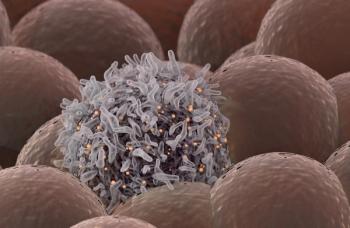
Study Moves the Needle for Melanoma Patients with Rare BRAF Mutations
BRAF and MEK inhibitors appear to have clinical activity in patients with metastatic melanoma with rare BRAF mutations.
BRAF and MEK inhibitors appear to have clinical activity in patients with metastatic melanoma with rare BRAF mutations, according to the results of a study published in the Journal of Clinical Oncology. Currently, BRAF and MEK inhibitors are approved for metastatic
“The best evidence would be a randomized trial, but given the rarity of these mutations, it’s difficult to accrue enough patients to really get some adequate data to power the trial,” said Daniel Wang, MD, assistant professor of medicine - medical oncology at Baylor College of Medicine and member of the Dan L Duncan Comprehensive Cancer Center in Houston, during an interview with CancerNetwork ®. “While this is retrospective, I think it’s probably the most reasonable way to generate some information about this rare population.”
Wang, who was not involved in the study, said that the main evidence for these targeted therapies in metastatic melanoma patients with rare BRAF mutations has been case reports or case series.
The retrospective study included a cohort of 103 patients with advanced melanoma and BRAF mutations other than V600E or V600K. Data were retrospectively evaluated for these patients who received a BRAF inhibitor, MEK inhibitor, or both between November 2009 and April 2018.
Patients were stratified by BRAF mutation into 2 groups: patients with a V600 mutation other than V600E or V600K (56%; 58 of 103 patients) and patients with a non-V600 mutation (37%; 38 of 103 patients). A total of 7 of the 103 study patients (7%) had both a V600E/K and a rare BRAF mutation and were excluded from the statistical analysis. The most common mutations identified were V600R (43%; 44 of 103), L597P/Q/R/S (15%; 15 of 103), and K601E (11%; 11 of 103).
Among the patients with a V600 mutation other than V600E or V600K, 6 of 22 (27%) responded to a BRAF inhibitor alone and 20 of 36 (56%) responded to combination therapy with a BRAF inhibitor and a MEK inhibitor. The median progression-free survival (PFS) was 3.7 months for the patients who received a BRAF inhibitor alone and 8.0 months for the patients who received combination therapy, a difference that was statistically significant (P = .002).
Among the patients with a non-V600 mutation, none of the 15 patients who received a BRAF inhibitor alone achieved a response, 2 of the 5 patients (40%) who received a MEK inhibitor alone achieved a response, and 5 of the 18 patients (28%) who received combination therapy with a BRAF inhibitor and a MEK inhibitor achieved a response. The median PFS was 1.8 months for the patients who received a BRAF inhibitor alone, 3.7 months for patients who received a MEK inhibitor alone, and 3.3 months for patients who received combination therapy.
In addition, according to a multivariate analysis, patients in either rare BRAF mutation group who received combination therapy had a better PFS and overall survival than those who received a BRAF or MEK inhibitor alone.
Currently the standard of care for metastatic melanoma patients with rare BRAF mutations is anti-PD-1 therapy with or without anti-CTLA-4 therapy.
“At this point, if I had a patient with one of these rare mutations, I would definitely consider immunotherapy upfront,” Wang said. “But if they were to progress on immunotherapy, it’d be reasonable to consider one of these BRAF/MEK inhibitor combinations.”
References:
Menzer, MD, C., et. al. (2019). Targeted Therapy in Advanced Melanoma With Rare BRAF Mutations | Journal of Clinical Oncology. [online] Ascopubs.org. Available at: https://ascopubs.org/doi/full/10.1200/JCO.19.00489 [Accessed 17 Oct. 2019].
Newsletter
Stay up to date on recent advances in the multidisciplinary approach to cancer.


















































































